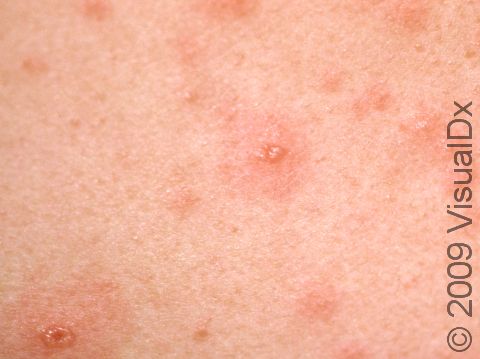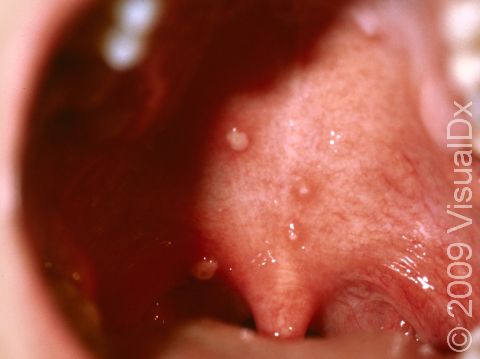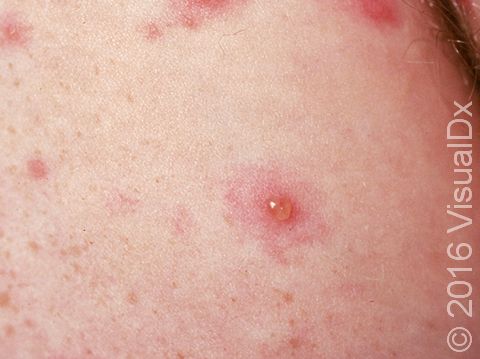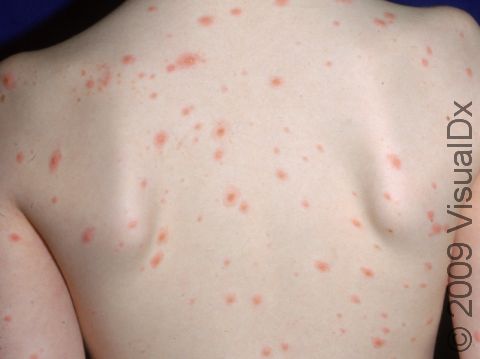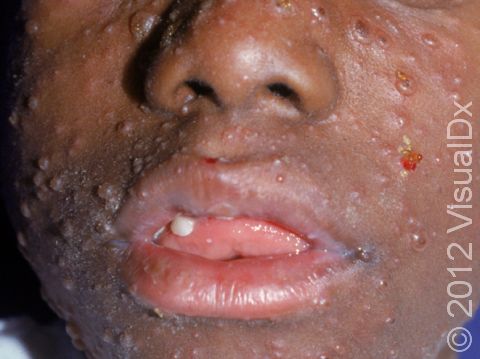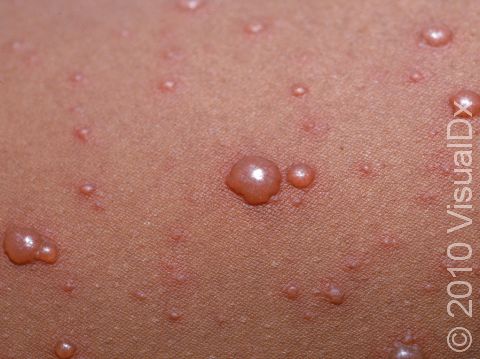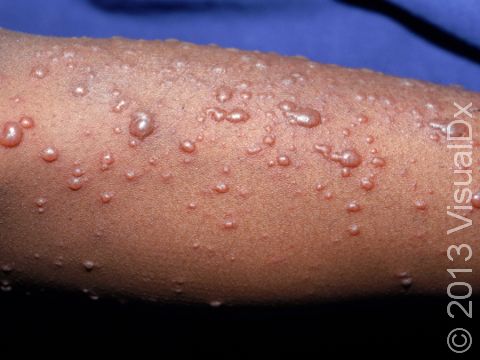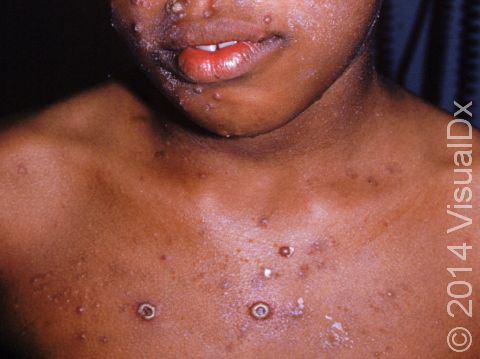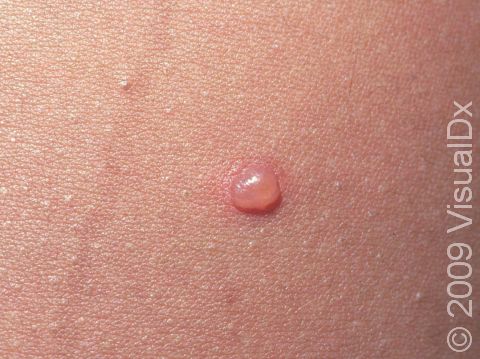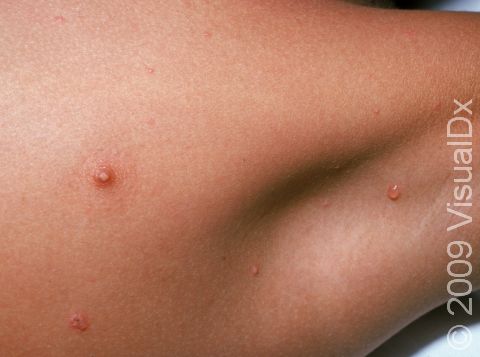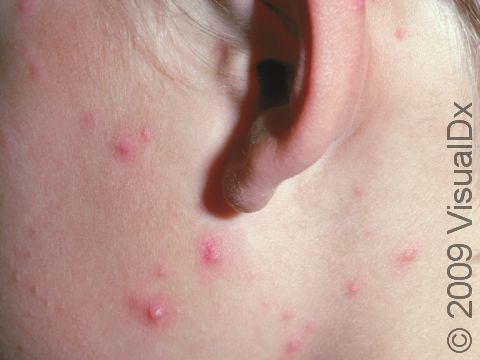Chickenpox (Varicella)
Varicella, commonly known as chickenpox, is an infection caused by the varicella-zoster virus. Infection spreads from person to person through fluids from the airways, such as from coughing and sneezing. The incubation period is 14-16 days, and the first obvious sign of disease is a rash. People are considered contagious for 2-5 days before the onset of the rash and for 6 days after the last series of rashes have appeared.
The most common complication is bacterial infection of lesions. Rare complications include lung infection (pneumonia) or brain infection (encephalitis). Children who have a weak immune system, eczema, or recent sunburn have more severe symptoms. Because the virus remains resting (latent) in the parts of nerve roots near the spinal cord for life, about 1 in 10 adults who have had chickenpox will get shingles (zoster) when the virus reappears, usually under conditions of stress to the body.
After having chickenpox, a person is usually immune for life, although reinfection is possible.
Who's At Risk?
Chickenpox occurs most commonly in children younger than 10 years. Children younger than 1 year whose birth mother had chickenpox usually do not become infected because they have some immunity from their mother’s antibodies, which were transferred to them before birth.
In many countries, the chickenpox vaccine has been part of routine childhood vaccinations (at age 12-18 months) since the 1990s. Most children who have been vaccinated avoid infection, but if they do become infected, their symptoms are generally mild.
Most infections occur between March and May.
Signs & Symptoms
Most children develop fever, lethargy, and other symptoms (eg, loss of appetite, headache, stomachache) for 1-3 days followed by a rash. These symptoms last for 2-4 days after the rash appears.
The rash is itchy and initially starts as pink-to-red macules (small, flat areas of skin) that quickly turn into papules (small, solid bumps) and then vesicles (fluid-filled blisters) with a surrounding halo of redness. In darker skin colors, the redness may be harder to see, or it may appear more purple. The rash usually appears first on the scalp or face, and then it spreads downward on the body. Linings of body cavities, such as inside the mouth or nose (mucous membranes), palms, and soles can have a few lesions. The average child develops a few hundred blisters, most of which heal without leaving scars. A child who has had the chickenpox vaccine will typically have far fewer lesions and less severe symptoms, in general.
The vesicles are usually described as looking like “a dewdrop on a rose petal” and are easily broken. Blisters become cloudy and then crust over, with healing completed within 1-3 weeks. Lesions often occur in 3 or more successive crops. Lesions in different stages of development may occur at the same time.
Self-Care Guidelines
Chickenpox resolves on its own after 1-3 weeks, but it is most important to keep the child comfortable and to discourage scratching, which can cause infection and scars.
For itch:
- Take oatmeal baths in lukewarm water.
- Take oral antihistamines such as diphenhydramine (eg, Children’s Zyrtec) during the day and chlorpheniramine (eg, Children’s Benadryl) at night.
- Keep the child’s fingernails short to help minimize skin breaks with scratching.
- Apply calamine lotion.
- DO NOT USE lotions containing antihistamines or lidocaine, as they are no more effective than the previous measures and might cause allergic reactions.
For pain and fever:
- You can give the child acetaminophen (eg, Children’s Tylenol).
Because chickenpox is highly contagious, keep the child at home until their symptoms are gone and all the blisters have crusted. Children with chickenpox should avoid pregnant people who have never had chickenpox, newborns, and people who have a weak immune system or eczema. Once all the blisters have dried up and scabbed, the child is no longer considered contagious to others.
Treatments
Antiviral medication may be given if the child is seen early (during the first day of the rash) and they are at higher risk for more severe chickenpox infection (those with asthma, eczema, recent sunburn, those taking aspirin or corticosteroids on a regular basis, or those with weak immune systems).
Visit Urgency
Most varicella infections do not require treatment.
If there are adults or teens in the household who have never had chickenpox or who have eczema, asthma, or a weakened immune system, have them contact their medical professional, as they may require antiviral medication. This usually needs to be done early (during the first day of the rash).
Call your child’s medical professional if the child has:
- Eczema, asthma, or a weakened immune system.
- A fever that lasts more than 4 days or is higher than 102°F (38.9°C).
- Areas of rash that look infected (eg, red, swollen, and leaking pus).
- A severe cough, vomiting, headache, drowsiness, confusion, stiff neck, trouble looking at bright lights, or difficulty walking or breathing.
Trusted Links
References
Bolognia J, Schaffer JV, Cerroni L. Dermatology. 4th ed. Philadelphia, PA: Elsevier; 2018.
James WD, Elston D, Treat JR, Rosenbach MA. Andrew’s Diseases of the Skin. 13th ed. Philadelphia, PA: Elsevier; 2019.
Kang S, Amagai M, Bruckner AL, et al. Fitzpatrick’s Dermatology. 9th ed. New York, NY: McGraw-Hill Education; 2019.
Paller A, Mancini A. Paller and Mancini: Hurwitz Clinical Pediatric Dermatology. 6th ed. St. Louis, MO: Elsevier; 2022.
Last modified on June 18th, 2024 at 4:15 pm

Not sure what to look for?
Try our new Rash and Skin Condition Finder
